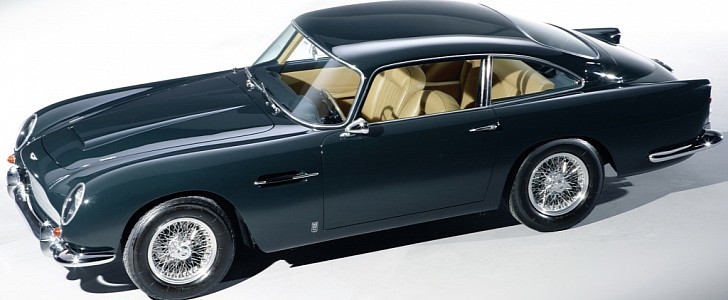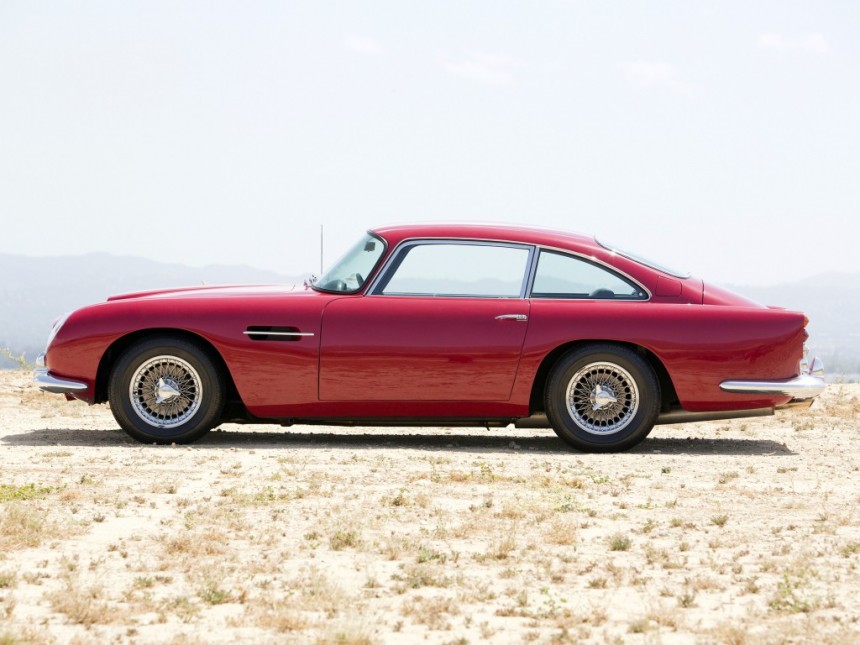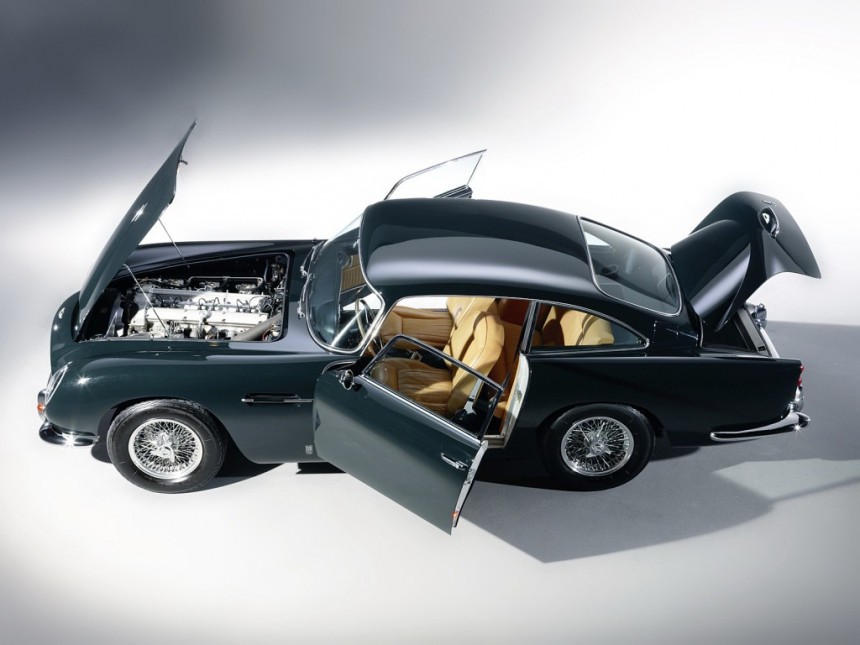Aston Martin. Two words that evoke imageries of a British spy driving his tricked-out car, but still, the DB5 isn’t only the quintessential Bond car.
The story of the four-seat grand tourer starts with David Brown, the man who purchased Aston Martin for a measly £20,500 in 1947 when the British Empire’s decline started to accentuate in the aftermath of World War II.
David Brown is the guy behind the DB series that defined the automaker’s postwar models. He’s also responsible for giving a Polish engineer a chance to prove his worth, a Polish engineer by the name of Tadeusz "Tadek" Marek who joined the company in 1954. He’s responsible for the straight-six engine of the DBR2 sports racing car, which was modified for road-going applications in 1958 when the DB4 was introduced with 240 horsepower on deck.
Clearly not a rehash of the DB Mark III it replaced because it had a platform instead of a tubular chassis, the DB4’s front-end styling was altered just a little bit for the DB5. Side note: engineer Harold Beach designed that platform in just six weeks. Both the DB4 and DB5 were styled by Carrozzeria Touring Superleggera, and both were produced at Newport Pagnell, the heritage site that’s currently the home of the classic department.
Greatly inspired by the DB4 GT, the DB5 can be considered a straightforward adaptation of the DB4 Vantage’s exterior design. The first example of the breed rolled off the line in July 1963, and back then, it was the only brand-new Aston Martin available to purchase. Based on the steel monocoque of the DB4, the newcomer was initially offered in 2+2 coupe and convertible guises. The Harold Radford-bodied shooting brake followed suit, and one of them sold at auction in August 2019 for a whopping $1.765 million.
Underneath the bite-the-back-of-your-hand pretty grand tourer, you’ll find double-wishbone independent front suspension with coil springs and an anti-roll bar for good measure. Typical for a car from this period, the rear end comes in the guise of a good ol’ solid axle and a Watt’s linkage.
Disc brakes on every corner provided stopping power with servo assistance. Behind the standard-issue wire wheels supplied by Borrani, the DB5 hides 11.5- and 10.8-inch disc brakes from Girling. Mounted with 15-inch rubber shoes from either Avon or Pirelli, the 2+2 cruiser features rear wing-mounted fuel tanks that feed a Tadek Marek-developed 4.0-liter engine.
Enlarged from 3.7 liters in the DB4, the aluminum-blocked mill is a little bit lighter than the DB4’s cast-iron lump. Other improvements include a higher compression ratio (8.8 to 1 versus 8.25 to 1) and a hydraulic vibration damper. Complemented by three SU HD8 carburetors, the straight-six engine cranks out 282 ponies and 288 pound-foot (390 Nm) of torque.
Initially offered with a four-speed manual from the DB4, the ultra-collectible DB5 could also be had with a five-speed stick shift. Customers were further offered a three-speed automatic transmission from BorgWarner, a very lazy gearbox that takes away from the driving experience.
Produced by Aston Martin in Newport Pagnell rather than Touring in Milan, the body panels of the DB5 are made from aluminum. Tipping the scales at 1,468 kilograms (3,236 pounds), the British model is much obliged to hit 100 kilometers per hour (62 miles per hour) in 6-something seconds. As for top speed, it is rated at 238 kilometers per hour (148 miles per hour).
In 1963 when the DB5 was brand new, Aston Martin charged a staggering £4,248 for the base specification that didn’t have air conditioning. That’s £94,785 adjusted for inflation, which converts to $128,625 at current exchange rates. “Staggering” may seem like an exaggeration although it’s not because the average price of a British house was far more affordable than a DB5. More specifically, the average house price was £2,840.
Goldfinger was released in September 1964, and it singlehandedly started the DB5 craze in grand fashion. The third movie in the 007 franchise stars the one and only Sean Connery with a very special DB5 finished in Silver Birch. In preparation for the release of the movie, Aston Martin further developed the 4.0L engine with revised camshaft profiles and Weber carburetors to create the Vantage. In this specification, the glorious-sounding straight-six develops 325 horsepower and 290 pound-foot (393 Nm) of torque.
From July 1963 through September 1965, the British automaker produced a grand total of 1,021 examples. Most of them were coupes (898), naturally, and the coupe also served as the basis for the Radford shooting brake.
Only 65 coupes and 12 convertibles were fitted with the Vantage-spec powerplant. We also need to mention 37 leftover convertible chassis that were adapted into the Short Chassis Volante. Essentially a DB5 with some DB6 updates, this variant ran from October 1965 through October 1966.
It’s also worth noting that Aston Martin has revived the DB5 as a continuation model in 2020, of which only 25 examples will ever be made.
David Brown is the guy behind the DB series that defined the automaker’s postwar models. He’s also responsible for giving a Polish engineer a chance to prove his worth, a Polish engineer by the name of Tadeusz "Tadek" Marek who joined the company in 1954. He’s responsible for the straight-six engine of the DBR2 sports racing car, which was modified for road-going applications in 1958 when the DB4 was introduced with 240 horsepower on deck.
Clearly not a rehash of the DB Mark III it replaced because it had a platform instead of a tubular chassis, the DB4’s front-end styling was altered just a little bit for the DB5. Side note: engineer Harold Beach designed that platform in just six weeks. Both the DB4 and DB5 were styled by Carrozzeria Touring Superleggera, and both were produced at Newport Pagnell, the heritage site that’s currently the home of the classic department.
Greatly inspired by the DB4 GT, the DB5 can be considered a straightforward adaptation of the DB4 Vantage’s exterior design. The first example of the breed rolled off the line in July 1963, and back then, it was the only brand-new Aston Martin available to purchase. Based on the steel monocoque of the DB4, the newcomer was initially offered in 2+2 coupe and convertible guises. The Harold Radford-bodied shooting brake followed suit, and one of them sold at auction in August 2019 for a whopping $1.765 million.
Disc brakes on every corner provided stopping power with servo assistance. Behind the standard-issue wire wheels supplied by Borrani, the DB5 hides 11.5- and 10.8-inch disc brakes from Girling. Mounted with 15-inch rubber shoes from either Avon or Pirelli, the 2+2 cruiser features rear wing-mounted fuel tanks that feed a Tadek Marek-developed 4.0-liter engine.
Enlarged from 3.7 liters in the DB4, the aluminum-blocked mill is a little bit lighter than the DB4’s cast-iron lump. Other improvements include a higher compression ratio (8.8 to 1 versus 8.25 to 1) and a hydraulic vibration damper. Complemented by three SU HD8 carburetors, the straight-six engine cranks out 282 ponies and 288 pound-foot (390 Nm) of torque.
Initially offered with a four-speed manual from the DB4, the ultra-collectible DB5 could also be had with a five-speed stick shift. Customers were further offered a three-speed automatic transmission from BorgWarner, a very lazy gearbox that takes away from the driving experience.
In 1963 when the DB5 was brand new, Aston Martin charged a staggering £4,248 for the base specification that didn’t have air conditioning. That’s £94,785 adjusted for inflation, which converts to $128,625 at current exchange rates. “Staggering” may seem like an exaggeration although it’s not because the average price of a British house was far more affordable than a DB5. More specifically, the average house price was £2,840.
Goldfinger was released in September 1964, and it singlehandedly started the DB5 craze in grand fashion. The third movie in the 007 franchise stars the one and only Sean Connery with a very special DB5 finished in Silver Birch. In preparation for the release of the movie, Aston Martin further developed the 4.0L engine with revised camshaft profiles and Weber carburetors to create the Vantage. In this specification, the glorious-sounding straight-six develops 325 horsepower and 290 pound-foot (393 Nm) of torque.
From July 1963 through September 1965, the British automaker produced a grand total of 1,021 examples. Most of them were coupes (898), naturally, and the coupe also served as the basis for the Radford shooting brake.
Only 65 coupes and 12 convertibles were fitted with the Vantage-spec powerplant. We also need to mention 37 leftover convertible chassis that were adapted into the Short Chassis Volante. Essentially a DB5 with some DB6 updates, this variant ran from October 1965 through October 1966.
It’s also worth noting that Aston Martin has revived the DB5 as a continuation model in 2020, of which only 25 examples will ever be made.





























